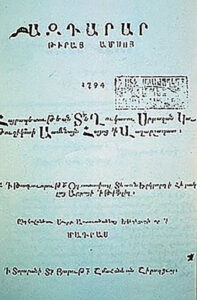The English word “press” has multiple meanings. It is a machine for imposing the impression of type on paper. It is printed matter as a whole, especially newspapers and periodicals. It consists of all the media and agencies that print, gather and transmit material to inform and educate the public.
The first newspaper was probably Tsing Pao, a court journal published in Peking (now Beijing), which is said to have started around 500 A.D. and continued until 1935. It was first produced from carved blocks instead of type. This method of printing was hundreds of years old in China by the time the paper began.
The first printed newspaper in Europe was introduced after Johann Gutenberg’s invention of printing from movable type around 1440. The first newspaper, Notizic Seritte, was published more than a century later in Venice, Italy in 1556.

The first Armenian periodical, a monthly called Azdarar, was published in Madras, India on October 16, 1794, by an Armenian priest named Father Haroutune Shmavonian. The appearance of Azdarar generated tremendous interest and enthusiasm and opened the floodgates of the Armenian press. Scores of Armenian dailies, journals, periodicals, monthlies and yearbooks were published in Europe, Asia Minor and Armenia beginning in the 19th century.
Today, more than two centuries since the publication of the first periodical, the Armenian press remains a vibrant and viable reality. From Armenia to the far corners of the Diaspora, practically every Armenian community sustains at least one newspaper or weekly—not to mention many other specialized periodicals and reviews, which contribute to the intellectual needs of Armenians throughout the world.
The Armenian press, along with the major Armenian institutions—the Armenian church, the Armenian school and the Armenian organizations—plays a very important role in the lives of the Armenian people.
The Armenian press is called to keep its readers informed and knowledgeable about events throughout the Armenian world. By keeping its readers informed, it enables them to understand themselves better—their strengths and their weaknesses—and respond to their needs through action.
Like most of the responsible press, the Armenian press has multiple functions. It informs its readers about the news; it educates; it provides guidance; it gives its readers the opportunity to think, analyze and digest information; it provides mental stimulation, broad perspective and improved command of language; it helps build vocabulary and general knowledge. Moreover, the role of the Armenian press is to publish news that deals with Armenians, whether they are positive or negative. News should be given objectively, as much as possible.
The Armenian press is called to keep its readers informed and knowledgeable about events throughout the Armenian world. By keeping its readers informed, it enables them to understand themselves better—their strengths and their weaknesses—and respond to their needs through action.
Furthermore, whether independent, party-owned or partisan, the Armenian press has a responsibility to be impartial and objective. Credibility as a source of news or information is a crucial test for any news media, electronic or print. Accurate and factual reporting of news stories is a categorical imperative of responsible journalism.
Armenian journalists, like all their fellow non-Armenian journalists, share a code of reportorial ethics. They must live by this code based on their duties. These are, briefly stated, to cover the news fairly, thoroughly and accurately; to report it as truthfully as possible; to explain what it means; to protect sources whenever necessary; and to respect confidence if it is freely offered and willingly accepted. However, while they should respect the privacy of others, responsible journalists should share any information that may affect the lives of the public.
As for its relationship with other news media, the representatives of the Armenian press must maintain strong ties with one another by exchanging news items and opinions. As a member of the family of the larger news media, the Armenian press should maintain a healthy relationship with non-Armenian media. This is not only a good gesture of public relations, but it is also a wise policy to make friends and influence people for the benefit of the Armenian Cause.
In the Armenian Diaspora, the preservation of national identity is of paramount importance. The dissemination of authoritative information by the Armenian press can motivate Armenians to manifest openly the will to survive as Armenians and can help the pursuit of the Armenian Cause.
As a final thought, a question arises in my mind. If the role of the Armenian press is such an important one, why is it that Armenians who invest so generously in the Armenian organizations treat the Armenian press as a “poor Lazarus?”



Be the first to comment